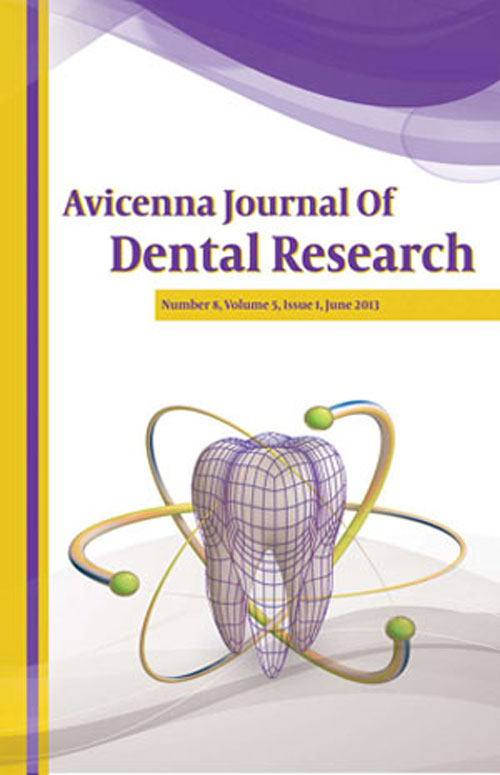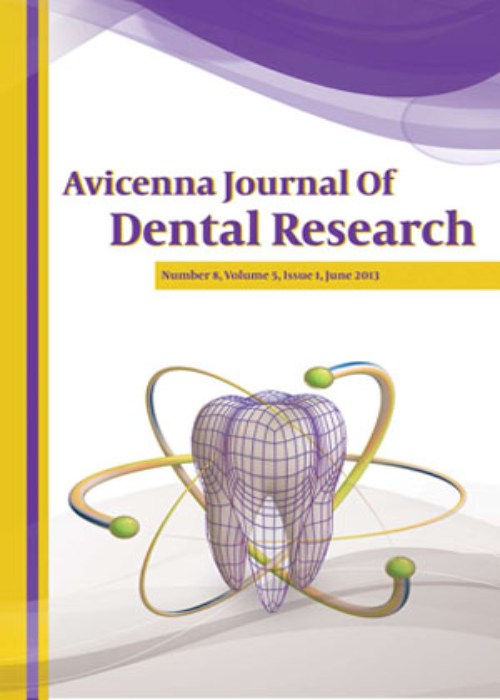فهرست مطالب

Avicenna Journal of Dental Research
Volume:11 Issue: 3, Sep 2019
- تاریخ انتشار: 1399/03/17
- تعداد عناوین: 7
-
-
Pages 79-82Background
Precise and quick diagnosis of jaundice in the neonates is of major medical and economic importance. Biomarkers in serum are regularly applied in clinical settings. Nevertheless, saliva could be a substitute to assess biomarkers. In this study, we aimed to detect the probable association between salivary and serum levels of bilirubin in jaundiced neonates.
MethodsA case-control survey was performed on 30 healthy neonates and 30 neonates with jaundice hospitalized in Mirzakhochekkhan and Baharloo hospitals, Tehran, Iran. Bilirubin levels were assayed in serum and unstimulated whole saliva by a photometric method. Pearson correlation and Student’s t tests were used for statistical analysis.
ResultsThe mean salivary and serum levels of total bilirubin were significantly higher in the neonates with jaundice compared to healthy individuals. A moderate correlation was observed between serum and salivary concentrations of total bilirubin.
ConclusionsSerum and salivary levels of bilirubin are meaningfully correlated in jaundiced neonates. This correlation may facilitate the monitoring and evaluation of bilirubin levels non-invasively for jaundice.
Keywords: Bilirubin, Jaundice, Neonate, Saliva -
Pages 83-88Background
Despite improvements in the optical properties of composite resins, their color stability is still a matter of discussion. This study sought to assess the effect of light intensity and curing time by a light-emitting diode (LED) light-curing unit on color stability of a methacrylate-based composite resin.
MethodsIn this in vitro study, 60 discs (8 × 2 mm) were fabricated of A2 shade of Z250 composite. Specimens were polished and divided into 4 groups (n=15) for curing for 20 or 40 seconds with a light intensity of 600 or 1200 mW/cm2 . After immersion in distilled water at 37°C for 24 hours, colorimetry was performed using a spectroradiometer. The specimens were then immersed in tea solution for 7 days (3 times a day, each time for one hour) and were subjected to colorimetry again. Color change (∆E) was calculated and analyzed using two-way ANOVA.
ResultsSignificant color change was noted following an increase in curing time (P<0.05). No improvement in color stability was noted after increasing the light intensity (P>0.05). The interaction effect of light intensity and curing time on color change was significant (P<0.05).
ConclusionsCuring time is an important factor affecting the color stability of composite resin polymerized with LED light curing unit. On the other hand, increasing the light intensity over the standard threshold showed no significant effect.
Keywords: Color, Compositeresin, Curing light, Lightintensity, Time -
Pages 89-93Background
Preterm labor is defined as labor before 37 weeks of gestation, which is associated with neonatal mortality. Due to contradictory results of studies conducted on the relationship between preterm labor and dental decays and lack of research in this regard in Iran, the present study was conducted with the aim of evaluating the relationship between DMFT (decayed, missing, and filled teeth) index and preterm labor in pregnant women in Hamadan.
MethodsThis study is a case-control study. The total number of samples was 227 pregnant women studied in two groups, 114 women in case and 113 women in the control group. The data collection method was interview and examination and the data collection tool was a questionnaire consisting of three sections, including demographic, midwifery, and dental information. The data were analyzed through SPSS software version 16.0 using descriptive and analytical statistics, independent t test and chi-square and at the significance level of P<0.05.
ResultsThe mean age of the subjects was 28.41±6.26 years. The mean score of the DMFT index was 13.02±6.20 in the case group and 10.70±6.12 in the control group, indicating a statistically significant difference between the two groups (P=0.005). The results showed that there was no significant relationship between DMFT index and preterm labor (P=0.779).
ConclusionsBased on the results of the study, the DMFT index is high in women with preterm labor, so providing necessary education before and during pregnancy by health service providers and mass media for pregnant women is essential to maintain and promote oral hygiene and reduce the complications of pregnancy.
Keywords: DMFT, Pregnancy, Preterm labor, Dental decay -
Pages 94-97Background
One of the most critical issues of cone-beam computed tomographic (CBCT) imaging is the presence of high-density subjects such as metal implants and dental fillings that consequently waste the benefit information in imaging due to their artifact developments. Given that 3D images of CBCT consist of a series of orthogonal images (images similar to lateral cephalometric images), the aim of this study was to offer an algorithm for detection of radiopaque dental materials from lateral cephalometric images to remove cupping artifacts from CBCT images.
MethodsIn this paper, lateral cephalometric images of Planmeca Scara 3 were used, each of which with 1259×1674 resolution in JPEG format. A total of 35 images of patients with radiopaque dental materials were selected. To decrease the time and image detection steps and for the purpose of acceleration we used Robinson edge detection and nonlinear gamma correction instead of filtering stage and noise reduction.
ResultsAfter applying the proposed algorithm to images and comparison with the acquired images, it was observed that the proposed algorithm was able to successfully detect radiopaque dental materials on lateral cephalometric images with high accuracy.
ConclusionsComparison of the reconstructed images and Table showed that the proposed algorithm was successful in detecting radiopaque dental materials on latral cephalometric images without reduction in image quality
Keywords: Lateralcephalometric images, Canny edge detector, Cupping artifact, Radiopaquedental materials, Nonlineargamma correction -
Pages 98-103Background
Electrolytes play a significant role in the regulation of various vital functions in the human body. Changes in electrolyte composition can be pre-operative, intra-operative, and post-operative. The aim of this study was to analyze the incidence of electrolyte imbalances after a maxillofacial surgery and find possible relationship between imbalances and kind of surgery.
MethodsIn this descriptive cross-sectional study, 101 maxillofacial surgery patients admitted to Besat educational hospital were selected by convenience sampling method. Serum electrolytes (sodium, potassium, calcium, and magnesium) of each patient were measured a day before the operation and on the first and the third post-operative days. The demographic and medical information and also details of the surgery of each patient were documented in checklists, which were used when all the needed data were collected. Statistical analysis was performed using SPSS version 23.0.
ResultsOur results showed that, among electrolyte imbalances, hypocalcemia was the most frequent with 26.3%, followed by hyponatremia with 18.7%, and hypermagnesemia with 16.6%, while potassium demonstrated the least changes (6.3%) after a maxillofacial surgery. There was a significant correlation between the body mass index (BMI) and magnesium (P=0.032) and calcium (P=0.021) imbalances (hypo or hyper). Statistical analyses showed that magnesium abnormalities are more common in patients with jaw trauma on the third post-operative day in comparison with first postoperative day (P=0.037).
ConclusionsHypocalcemia, hyponatremia, and hypermagnesemia are relatively common after maxillofacial surgeries. The findings showed that some factors such as the BMI and etiology of maxillofacial surgeries could cause electrolyte abnormalities after maxillofacial surgery. Identifying these factors could be useful in planning strategies for prevention, diagnosis, and early treatment of possible complications, which, in turn, may result in an improvement in the quality of care.
Keywords: Electrolytedisorders, Sodium, Potassium, Magnesium, Electrolyte imbalance, Maxillofacial surgery -
Pages 104-107
Squamous cell carcinoma (SCC) of the oral cavity ranks as the 12th most common cancer in the world and the 8th most frequent cancer in males. Oral cavity SCC (OCSCC) is extremely unusual in the pediatric population. Researchers believe that the pathology of SCC in pediatric patients is a separate entity different from SCC in the adult population. SCC is a malignant and clinically variable epithelial neoplasm. When located in the gingiva, this neoplasm may mimic common inflammatory lesions. This neoplasm is generally more frequent in males than in females, but this is not observed in cases of SCC located in the gingiva. Usual risk factors such as tobacco and alcohol exposure are typically absent.
Keywords: Pediatric cancer, Gingivobuccal complex, Gingival neoplasms, Carcinoma, Oral -
Pages 108-110Background
Complete debridement is the major key to successful non-surgical endodontic treatment in teeth with periapical lesions. The missed canals serve as a harbor for bacteria and the irritant factors that lead to treatment failure. Most anatomical studies found that the maxillary lateral incisor is a singlerooted tooth. Most cases reported about the maxillary lateral incisors with two roots are the result of fusion or gemination and are usually accompanied by an enlarged crown. However, a few studies reported that the crown dimensions were normal. Knowing this unusual anatomy helps clinicians to treat patients more efficiently with less chance of failure.
Case PresentationThis case report describes successful endodontic management of an uncommon variation of the maxillary lateral incisor with two root canals. Based on the clinical and radiographic findings, pulp necrosis and symptomatic apical periodontitis were diagnosed. The tooth received root canal treatment. The patient was followed up for 6 months and clinical and radiographic examinations in the follow-up sessions showed improvement in the periapical condition and the tooth became asymptomatic.
ConclusionsDue to the wide morphological variations in the root and the root canal system of the teeth, clinicians should have knowledge of any anatomical variation to minimize the risk of endodontic treatment failure following inadequate debridement of indistinguishable or inaccessible portions of the root canal system.
Keywords: Two-rootedmaxillary lateral incisor, Rootcanal therapy, Anatomicalvariation


